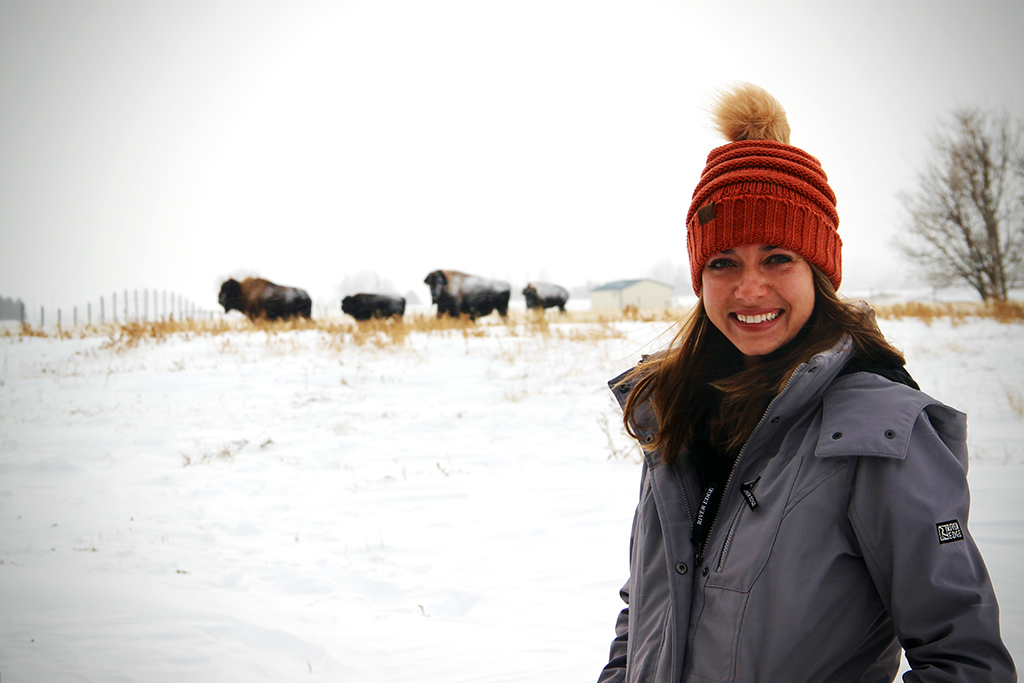
New USask research helps rescue threatened bison
Fast like the wind, baby bison Skeeter happily runs to his mum across the pastures of USask's Livestock and Forage Centre of Excellence (LFCE).
By Federica Giannelli
Skeeter is one of two wood bison calves born thanks to USask PhD student Miranda Zwiefelhofer, who developed new protocols for in vitro fertilization in bison. Zwiefelhofer was the first to successfully use frozen-thawed embryos produced from immature eggs collected from live bison.
The results are an extension of a protocol she developed for bison egg collection published in Reproduction, Fertility and Development, and presented at the annual conference of the International Embryo Technology Society.
“Our advances in assisted bison reproduction are aiding conservation efforts across Canada and the United States by creating a genome biobank with embryos and semen that will help preserve the genetic diversity of the Plains Bison and the Wood Bison,” said Zwiefelhofer. “The latter is a species that evolved in the boreal forests of Canada, so I really hope my work will help make a difference for their conservation.”
This fall, Zwiefelhofer transferred 26 more embryos into surrogate Wood Bison mothers to compare pregnancy rates of fresh embryos to two different freezing methods. She currently has four successfully impregnated bison due next summer—two each from her freeze-thaw method and from fresh embryos, confirming her method is equally successful.
“More than any other North American species, bison symbolize the evolution of the continent’s ecosystem and the physical and spiritual wellbeing of its human inhabitants,” said USask veterinary biomedical sciences professor Gregg Adams, Zwiefelhofer’s supervisor.
“But despite their critical importance as an ecological and cultural keystone species, bison underwent near extinction due to overhunting and systematic slaughter in the late 19th century due to the colonial expansion in the West.”
Millions of bison once roamed freely across North America. Even though some large herds currently live in national parks, their survival is still at risk as they are vulnerable to diseases that typically affect domestic livestock. Also, hybridization between the Wood Bison and Plains Bison subspecies and historical inter-breeding with cattle put the species at further risk.
“The problem is that bison herds are so scattered across North America that they wouldn’t be able to meet and mate naturally, so we’re helping with that,” said Zwiefelhofer. “The bison embryos and semen can be frozen for years and can lead to the birth of healthy calves.”
In vitro fertilization is a common practice for cattle reproduction, so scientists know well the procedures for producing and freezing embryos, but for bison they are still being explored. Zwiefelhofer had to figure out when and how embryos could be frozen to result in a successful pregnancy. The answer, she discovered, is at the morula stage, seven to eight days after fertilization.
The finding is key to transporting embryos safely among herds and across borders. The embryos are first “washed” with enzymes to remove any transferable diseases and then frozen to be easily transported.
Zwiefelhofer moved from the U.S. to pursue her studies at USask because she wanted to make a difference in wildlife conservation as part of the USask Bison Research Group.
“I like having a project that could change how people think about species conservation,” she said. “It is tangible. Having live calves on the ground after going through the whole process really shows that we are going in the right direction.”
The USask research is funded by the federal agency NSERC and the Saskatchewan Agriculture Development Fund.
Federica Giannelli is a graduate student intern in the USask research profile and impact unit.
This article first ran as part of the 2020 Young Innovators series, an initiative of the USask Research Profile and Impact office in partnership with the Saskatoon StarPhoenix.
Article re-posted on .
View original article.
